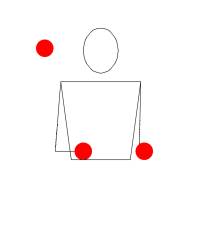| 42 | |
|---|---|
 2 in 1 hand with a hold | |
|
Capacity |
3 |
|
Period |
2 |
|
Full period |
4 |
|
Orbits |
2 |
|
Composition |
Prime |
|
(Ground state) | |
|
32 | |
|
Self-dual | |
| (4x,2)(2,4x) | |
|---|---|
 3 ball slow cascade at 4 ball height | |
|
Capacity |
3 |
|
Period |
4 |
|
Full period |
12 |
|
Orbits |
1 |
|
Composition |
Prime |
|
(1,1)(1,0) - (4x,2) | |
|
(3x,2)* | |
| 522 | |
|---|---|
 3 ball slow cascade at 5 ball height | |
|
Capacity |
3 |
|
Period |
3 |
|
Full period |
9 |
|
Orbits |
1 |
|
Composition |
Prime |
|
(Ground state) | |
|
322 | |
Every juggling pattern can be written in siteswap notation an infinite number of different ways.
3 ball slow cascades[]
There are twelve different ways to notate the 3 ball cascade (defined as a 3 ball pattern where the two hands alternately make crossing throws at a fixed height on an even rhythm) in siteswap with a maximum throw value of 9:
All of these siteswaps represent essentially the same pattern, but the different ways of writing it imply different heights and dwell times. If higher throws, uneven rhythms, or varied throw heights are allowed, then there are even more ways to write the pattern, such as b22222222, 5520, and 722520.
- Video: 65 variations of (4x,2)* with active 2s
Synonyms for other basic patterns[]
The 4 ball asynch fountain can be written with a maximum throw value of 8 as:
The 4 ball synch fountain can be written with a maximum throw value of 8 as:
The 5 ball cascade can only be written two ways without exceeding a throw value of 9: 5 and (8x,2)*. Other ways to write this pattern using higher throws include:
Repetitions, rotations, and reflections[]
A siteswap can also be written in different ways by repeating the sequence of numbers: 744, 744744, 744744744, etc. all represent the same pattern, but a siteswap pattern is normally expressed in the shortest possible form (no repetition).
Patterns containing more than one throw height, such as "...123451234512345...", can be written several different ways without repetition, since a variety of starting points are possible for the notation. 12345, 23451, 34512, 45123, and 51234 all represent the same pattern, since they all look the same when written as an indefinitely repeating sequence.
Switching the numbers in each pair of throws in a synchronous pattern, for example changing (6x,4)(2,4x) to (4,6x)(4x,2), results in another way of writing the same pattern. If you consider the number to the left of a comma to always be a left hand throw (or if you consider the number to the left of a comma to always be a right hand throw), then the new notation represents the mirror-image version of the original pattern.
Synch, asynch, and one-handed patterns[]
A shower pattern can be written either in asynchronous notation or in synchronous notation. There is not much difference between the asynch patterns 51, 71, 91, and the synch patterns (4x,2x), (6x,2x), (8x,2x), and in practice the shower is commonly done with a rhythm in between synch and asynch. (Jugglers usually use a high dwell time, which makes it impossible to do 1s with a perfect asynch rhythm.) Sprung patterns, which are normally written in synchronous notation, can also be written as asynch patterns ( e.g. 612 instead of (4,2x)* and 912 instead of (6x,2x)* ).
One-handed patterns are exactly the same whether they're written in asynch notation or in synch notation since one hand isn't doing anything, so there are no throws to be synchronized. If the 0 in the siteswap for a one-handed pattern is replaced with a 2, there is still no difference in the pattern except that the hand that isn't juggling is now holding an object. So 2 in 1 hand can be written as 40, (4,0), 42, or (4,2), 3 in 1 hand can be written as 60, (6,0), 62, or (6,2), and 4 in 1 hand can be written as 80, (8,0), 82, or (8,2).

42 ~ Three Ball Siteswap
3 ball 42 by Robert Wood



